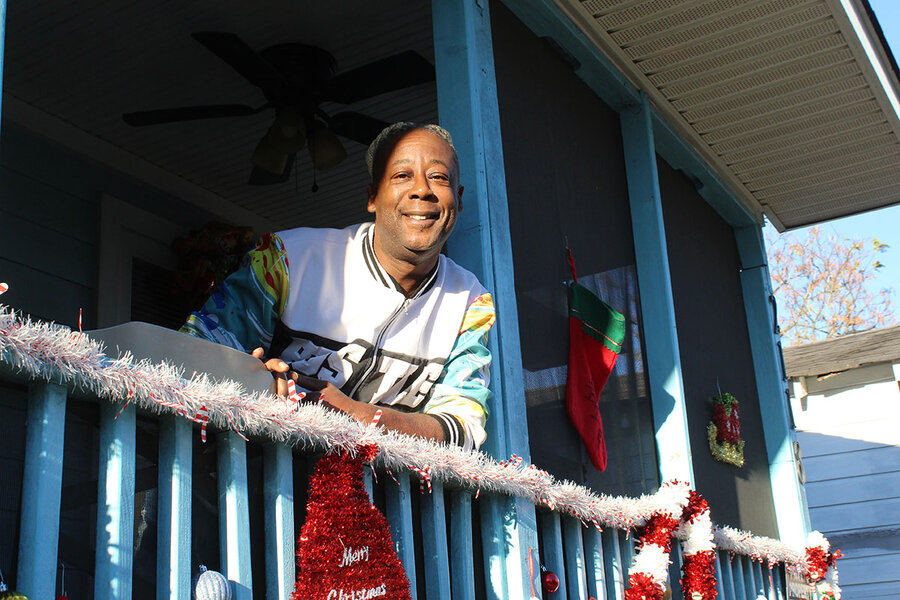How does gerrymandering change US politics? Look at this district.
Loading...
| Charleston, S.C.
South Carolina’s 1st Congressional District essentially traded Lester Aiken for Steve English.
In redrawing the state political map in 2020, Republicans pushed out Mr. Aiken, who is Black and leans liberal, and brought in Mr. English, who is white and leans conservative.
To talk to the two voters about it, the switch might not seem like such a big a deal. Mr. Aiken’s isn’t bothered by the charge that his neighborhood was moved because it is predominantly Black. “I don’t look at the world in Black and white,” he says.
Why We Wrote This
The 1st Congressional District in South Carolina was trending blue. Now it’s deep red. In the change is the story of modern American politics.
Mr. English, who lives in rural Berkeley County, agrees. “I get it. We’re country, and they’re the city; we’re conservative, and they’re liberal,” the third-generation fishing guide says. “But we probably have more in common than we don’t.”
Yet the new political map has brought a revolution. A district that was trending left has now veered starkly right. And beyond Charleston, a state that was seeing new shoots of Democratic support is now represented by Republicans in six of seven districts.
“Too poor to paint, too proud to whitewash,” a Charleston saying used to go. Now the GOP has effectively painted one of the South’s most liberal corners red. A lawsuit challenging the legitimacy of the redrawn district has made it to the United States Supreme Court.
There is no question the state remains deeply conservative. And it is also clear that Democrats engage in gerrymandering, too. An Associated Press study found that neither side has gained a decisive numerical advantage. “Republicans won just one more U.S. House seat in 2022 than would have been expected based on the average share of the vote they received nationwide,” the report found.
But how does the nation’s polarized politics emerge from voters as seemingly affable and reasonable as Messrs. Aiken and English? The 1st District shows not only how polarized districts elect redder and bluer representatives, but also how they accelerate a sense of estrangement.
Aggressive partisan redistricting “starts to disconnect people from their ... representation,” says Doug Spencer, an election scholar at the University of Colorado Law School in Boulder. Those people, in turn, “start to look at political bodies and realize that it’s not a reflection of the underlying population.”
Supreme Court scrutiny
The 1st District legal case is one of a dozen court challenges across the Sun Belt, where a rising share of the nation’s population is gravitating. It alleges that lawmakers illegally “bleached” the 1st District of 30,000 Black voters, most of whom, like Mr. Aiken, lean Democratic. A panel of three federal judges ruled that the new electoral map could only be interpreted as “stark racial gerrymander,” which, unlike partisan gerrymandering, is illegal.
At an October hearing, several U.S. Supreme Court justices seemed skeptical about the legal merits of that argument. But focusing only on the legality of the move misses the deeper point, says Professor Spencer.
“The 1st District is really a great microcosm of the American story in this moment,” he says. “If we’re just thinking about the baseline rule of what is ... technically legal, then we’re missing out on what makes our democracy function. Is there a commitment to winning elections through ideas and mobilization? Or is it that we’re going to change and embed structures in a way that keeps us in power? Those are two different sets of values, and you can’t write those values into law.”
The results in the 1st District have been striking.
Six years ago, the 1st Congressional District elected a Democrat for the first time in 30 years. Newcomers drawn to the state’s low taxes and light regulation had been ironically bending the state’s politics gradually leftward.
After redistricting, Republican Nancy Mace won, though narrowly. Now, she’s winning comfortably, and her rhetoric has changed. She became an outspoken player in the battle over the House speakership, at one point donning a “Scarlet Letter”-type “A” on her shirt. She has also floated herself as a possible vice presidential candidate for former President Donald Trump, despite clashes with him.
“Back when Nancy Mace had won by a razor-thin margin over a Democrat, she had to pay a lot more attention ... to both Democrats and Republicans in the district,” says DuBose Kapeluck, a political scientist at The Citadel in Charleston. Now “her job has become a lot easier, and she can vote the reliably Republican way.”
In Bennett’s Point, a remote fishing village south of Charleston, 1st District resident Nathan Hollinger says voters are being used as pawns.
“Politicians are trying to segregate us by ideology, party, race, and ethnicity, for their own benefit,” he says. “The focus is on the circus in Washington, and that’s how they like it.”
Not as red as it seems?
Even now, the 1st District has more texture than the maps might suggest. Representative Mace has cast herself as a maverick. (She was the first woman to graduate from The Citadel, Charleston’s famed military college.) She has championed women’s rights, marijuana legalization, and a ban on offshore drilling.
New 1st District voter Mr. English also says there’s more to him than “anybody but Biden.” Even as a fiscal conservative, he says lawmakers need to address the impacts of growth on communities. “There should be a more significant impact fees on developers so that new development helps fund better schools and roads,” he says.
Yet the new 1st District epitomizes a United States where residents are self-segregating – and being mapped – into ideological chunks. America is no longer a melting pot. It’s more of a “lumpy salad bowl,” says James Gimpel, a political scientists at the University of Maryland.
In Charleston, Mr. Aiken is aware of these trends. He says he knows the new voting maps are meant to secure political power at the risk of driving Americans further apart. But he has hope the spirit of the city can overcome partisan instincts.
“The most important thing to me is what I see around me, which is a city on the rise,” he says. “This is about coming together as communities and voters to do what’s best for where we live.”








